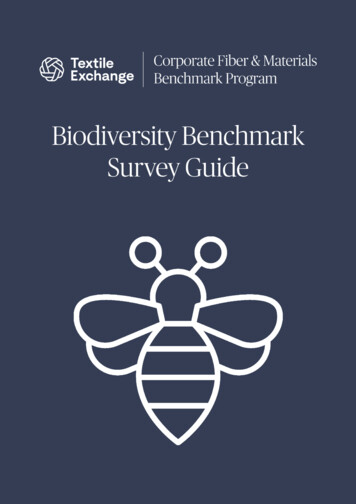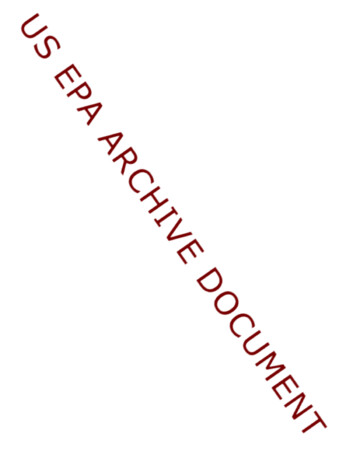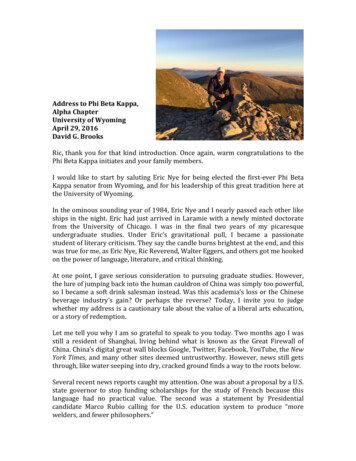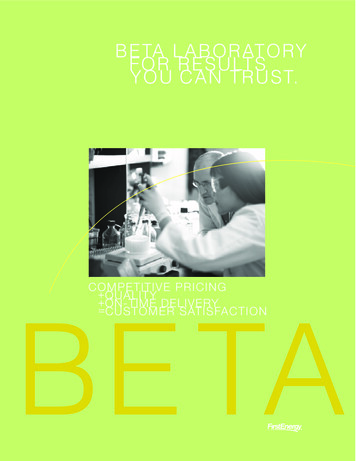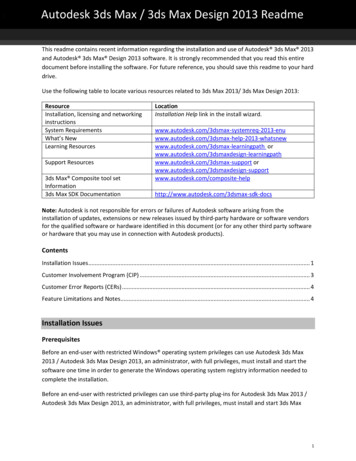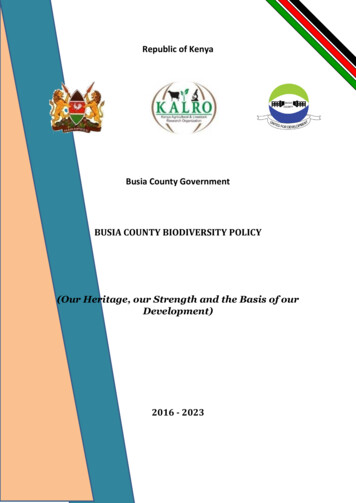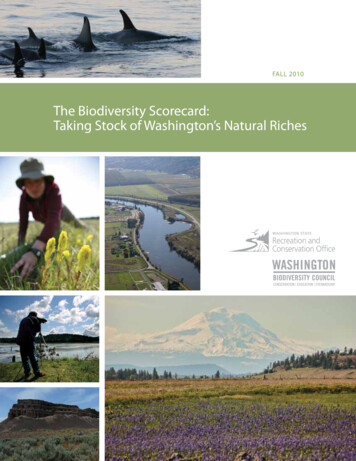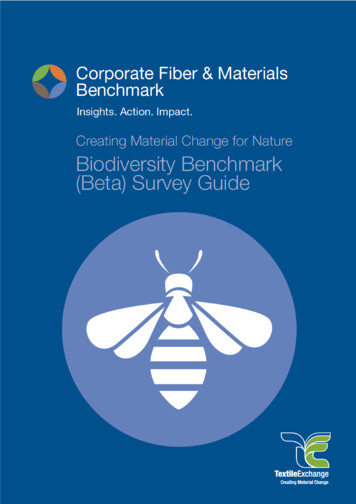
Transcription
Quick Navigation:BM-P Overview BM-1 Business Integration BM-2 Transparency BM-3 Materiality BM-4 Implementation BM-5 Monitoring andEvaluation BM-6 ReportingBiodiversity Benchmark (Beta) Survey GuideFor support contact: CFMB@TextileExchange.orgTextile Exchange 2020 Page 1 of 75
Version 1Copyright Textile ExchangeDecember 2020AcknowledgementsThe Biodiversity Benchmark and following guidance have been developed by Textile Exchange inpartnership with The Biodiversity Consultancy and Dr. Helen Crowley (advisor to ConservationInternational), during her sabbatical from The Kering Group, and in consultation with Textile Exchange’sBiodiversity Advisory Group. Made possible by the generous support of Sappi Ltd.Quick Navigation:BM-P Overview BM-1 Business Integration BM-2 Transparency BM-3 Materiality BM-4 Implementation BM-5 Monitoring andEvaluation BM-6 ReportingBiodiversity Benchmark (Beta) Survey GuideFor support contact: CFMB@TextileExchange.orgTextile Exchange 2020 Page 2 of 75
ContentsGlossary .4Why Biodiversity, Why Now? .6Part I: The Biodiversity Benchmark .9The Biodiversity Benchmark (Beta Version).10BM-P1. Materials Portfolio .12BM-P2. Biodiversity Prioritization .15BM-1. Business Integration .17BM-2. Transparency .26BM-3. Materiality .30BM-4. Implementation.35BM-5. Monitoring and Evaluation .45BM-6. Reporting .49Part II: Appendix .51Appendix 1: Key Terms and Definitions .52Appendix 2: Key Initiatives .62Appendix 3: Biodiversity Advisory Group .67Biodiversity Benchmark Development Team .74The Biodiversity Benchmark Survey Guide provides pragmatic guidance to help companies completethe survey. While a company’s biodiversity strategy is being fully developed and science-basedtargets confirmed, we advocate for a “no regrets” approach to action. The no-regrets approach(defined by the UNDP, UNEP, and IUCN and expressed by the Science Based Targets Network)focuses on maximizing positive and minimizing negative aspects of nature-based adaptationstrategies and options. No-regret actions include [ ] measures taken which do not worsenvulnerabilities [e.g., to climate change] or which increase adaptive capacities and measures that willalways have a positive impact on livelihoods and ecosystems [e.g., regardless of how the climatechanges]. Textile Exchange is a member of the Science Based Targets Network EngagementProgram.Recommended citation: Textile Exchange and The Biodiversity Consultancy (2020) Corporate Fiber& Materials Benchmark: Creating Material Change for Nature, Biodiversity Benchmark (Beta) SurveyGuide.Quick Navigation:BM-P Overview BM-1 Business Integration BM-2 Transparency BM-3 Materiality BM-4 Implementation BM-5 Monitoring andEvaluation BM-6 ReportingBiodiversity Benchmark (Beta) Survey GuideFor support contact: CFMB@TextileExchange.orgTextile Exchange 2020 Page 3 of 75
GlossaryBiodiversity: The variability among living organisms from all sources including terrestrial, marine and otheraquatic ecosystems and the ecological complexes of which they are a part. This includes variation in genetic,phenotypic, phylogenetic, and functional attributes, as well as changes in abundance and distribution over timeand space within and among species, biological communities, and ecosystems (CBD, IPBES).Circular economy: An economy based on the principles of designing out waste and pollution, keeping productsand materials in use, and regenerating natural systems (Ellen MacArthur Foundation).Climate : Textile Exchange’s strategic intent over the next 10 years is to be a driving force for urgent climateaction in textile fiber and materials production, specifically: enabling and guiding the textile industry to reduceGHG emissions (CO2 equivalents) by 45 percent by 2030 in the pre-spinning phase of textile fiber and materialsproduction; and amplifying positive impacts in soil health, water, and biodiversity (Textile Exchange).Conservation: The protection, care, management and maintenance of ecosystems, habitats, wildlife species andpopulations, within or outside of their natural environments, in order to safeguard the natural conditions for theirlong-term permanence (IUCN Glossary).Conversion: Change of a natural ecosystem to another land use or profound change in a natural ecosystem’sspecies composition, structure, or function. Deforestation is one form of conversion (conversion of naturalforests) (Accountability Framework).Corporate Fiber & Materials Benchmark (CFMB) Program: Textile Exchange’s robust benchmarking structurethat helps companies systematically measure, manage and integrate a preferred fiber and materials strategy intomainstream business operations, to compare progress, and to transparently communicate performance tostakeholders. The CFMB program generates the Material Change Index, the Materials Impact Dashboard,confidential company scorecards, and data-driven insight reports (Textile Exchange).Decarbonization: The process of reducing “carbon intensity,” lowering the amount of greenhouse gas emissionsproduced by the burning of fossil fuels (IPCC).Deforestation: Loss of natural forest as a result of: i) conversion to agriculture or other non-forest land use; ii)conversion to a tree plantation; or iii) severe and sustained degradation. (Accountability Framework).Material: A textile material is a specific substance which is used to make textiles. A material is either a fiberwhich is transformed into yarn or a “non-fiber” material (Textile Exchange).Materials program: Refers to a material produced according to sustainability specifications (in an industrystandard, certification scheme, regulation, initiative or process) and distinguished by the company to have ahigher sustainability performance than conventional materials. Textile Exchange classifies a “conventional”material as a material which is not produced to the specifications of a sustainability program I.e., standard,certification, regulation, initiative or process (Textile Exchange).Nature: All non-human living entities and their interaction with other living or non-living physical entities andprocesses (IPBES Glossary). This definition recognizes that interactions bind humans to nature, and itssubcomponents (e.g., species, soils, rivers, nutrients), to one another. This definition also recognizes that airpollution, climate regulation, and carbon are part of “nature” more broadly, and therefore, when we talk aboutacting for nature, we are talking about acting on issues related to climate change as well (SBTN).Nature’s contributions to people: All the contributions, both positive and negative, of living nature (i.e., diversity oforganisms, ecosystems, and their associated ecological and evolutionary processes) to the quality of life forpeople (IPBES Glossary).Natural capital: The stock of living and non-living, renewable and non-renewable natural components ofecosystems that enable nature’s contributions to people (Natural Capital Coalition).Natural climate solutions: Actions which are concerned with capturing carbon through conservation, ecosystemrestoration and improved land management across global forests, wetlands, grasslands, and agricultural lands(Conservation International).Quick Navigation:BM-P Overview BM-1 Business Integration BM-2 Transparency BM-3 Materiality BM-4 Implementation BM-5 Monitoring andEvaluation BM-6 ReportingBiodiversity Benchmark (Beta) Survey GuideFor support contact: CFMB@TextileExchange.orgTextile Exchange 2020 Page 4 of 75
Natural ecosystem: An ecosystem that substantially resembles—in terms of species composition, structure, andecological function—one that is or would be found in a given area in the absence of major human impacts. Thisincludes human-managed ecosystems where much of the natural species composition, structure, and ecologicalfunction are present. (Accountability Framework).Preferred material: Textile Exchange defines a “preferred” fiber or material as one which is environmentallyand/or socially progressive, the use of which results in positive benefits in comparison to conventional production(Textile Exchange).Priority material: For the purposes of benchmarking, Textile Exchange defines a priority material by the scale,risk and opportunity it represents to the company. Scale: The "fiber" represents a percentage of volumetric use beyond a threshold of 10 percent of overallfiber use e.g., cotton, polyester, manmade cellulosic fibers, nylon, and wool. Or, in the case of "non-fiber”materials (e.g., leather, down), it represents 10 percent of the final product range (i.e., by "count of products"with "major components" of non-fiber materials e.g., down or leather). Risk: The raw material represents a "material" risk to the company. Risks associated with a minority (lowvolume) raw material include sourcing from environmentally and/or socio-economically high-risk sourcingregions, animal welfare risk, reputation risk, etc. Opportunity: The module should also be selected if the company has seized the opportunity to advance thesustainability of the raw material even if the material is below the volumetric use threshold or is notconsidered a risk (Textile Exchange).Species: An interbreeding group of organisms that is reproductively isolated from all other organisms, althoughthere are many partial exceptions to this rule in particular taxa. Operationally, the term species is a generallyagreed fundamental taxonomic unit, based on morphological or genetic similarity, that once described andaccepted is associated with a unique scientific name (IPBES Glossary).Sustainable Development Goals: The SDGs are a set of 17 goals that were adopted by all 193 Member States ofthe United Nations on September 25th, 2015, to end poverty, protect the planet, and ensure prosperity for all aspart of a new sustainable development agenda. Each goal has specific targets to be achieved by 2030. Fulfillingthese ambitions will take an unprecedented effort by all sectors in society – and business has to play a veryimportant role in the process (United Nations).Wildlife: Living things that are neither human nor domesticated. This includes both fauna and flora, as well aswildlife living in the wild (in-situ) and in captivity (ex-situ). For the purposes of this Biodiversity Benchmark, wefocus primarily on in-situ wildlife and its conservation (adapted from IUCN Glossary).Further terminology guides and resources can be found in the appendix, and short definitions are providedthroughout the body of the guide. For more information on the Corporate Fiber & Materials Benchmark programand the suite of guides please visit: https://mci.textileexchange.org/Quick Navigation:BM-P Overview BM-1 Business Integration BM-2 Transparency BM-3 Materiality BM-4 Implementation BM-5 Monitoring andEvaluation BM-6 ReportingBiodiversity Benchmark (Beta) Survey GuideFor support contact: CFMB@TextileExchange.orgTextile Exchange 2020 Page 5 of 75
Why Biodiversity, Why Now?“It is the sourcing of raw materials that is the direct interface between business and nature. Throughsustainable sourcing and reconfiguring supply chains, we can help drive change in agriculture, mining, andforestry, and promote regenerative, wildlife-friendly approaches to production.”Dr. Helen Crowley, Conservation International’s Senior Advisor on Resilient Supply ChainsBiodiversity – the fabric of life created by genes, species and ecosystems and all their complexinteractions – is being lost at an alarming pace.The links between the COVID-19 outbreak and biodiversity loss are clear (Nature). Increasing habitatfragmentation, land use change, and wildlife exploitation globally are exacerbating risks for both globalbiodiversity and human health. Tragically, at the time of writing, the COVID-19 pandemic has resulted inover 1.2 million deaths and 50.5 million cases in 219 countries, areas, or territories worldwide (WHO). Thishas resulted in increased calls for a One Health approach to disease prevention, which recognizes theinterconnection between the health of people, animals, plants, and their shared environment (CDC).Disease emergence, natural disasters, food insecurity, and other increasing threats have driven the issueof biodiversity loss higher up the political, business, and societal agenda.In 2019, the scientific community released its latest report (IPBES Global Assessment) on the status ofspecies and ecosystems. The report found that around 1 million animal and plant species are nowthreatened with extinction, many becoming threatened within decades, more than ever before in humanhistory. These dramatic results highlight what the Stockholm Resilience Center has also shown in relationto planetary boundaries: we are beyond the safe operating space for humanity when it comes to thedegradation of our biosphere. The World Economic Forum (WEF) positions nature loss as one of thegreatest systemic risks to the global economy and the health of people and the planet.The time is right to do something about biodiversity.The Dasgupta Review released its full report earlier this year. This independent, global review on theEconomics of Biodiversity is led by Professor Sir Partha Dasgupta (Frank Ramsey Professor Emeritus,University of Cambridge). The Review was commissioned by HM Treasury and is positioned to do forbiodiversity what the Stern Review did for climate change in emphasizing that the benefits of strong, earlyaction outweigh the costs.“As we entered the Decade of Action to deliver the UN Sustainable Development Goals, expectations werehigh that we would see strides towards a consensus that places nature at the heart of the conversationaround the climate emergency.The World Economic ForumThe year 2020 has been coined the “super year” for nature by the United Nations Environment Program,among many others. The United Nations Summit on Biodiversity was held in September 2020; in response,64 world leaders (and counting) from 5 continents have signed the Leaders’ Pledge for Nature, committingto place wildlife and the climate at the heart of post-pandemic economic recovery plans, addressing theclimate crisis, deforestation, ecosystem degradation, and pollution.The 15th Conference of Parties (COP) of the Convention on Biological Diversity (CBD) was to be held inKunming, China, in October 2020. There are 196 Parties to the CBD as of November 2020. COP 15 hasbeen rescheduled for the second quarter of 2021, at which time the Parties will review the achievementsand delivery of the CBD’s Strategic Plan for Biodiversity 2011-2020 and are expected to finalize the post2020 global biodiversity framework.Quick Navigation:BM-P Overview BM-1 Business Integration BM-2 Transparency BM-3 Materiality BM-4 Implementation BM-5 Monitoring andEvaluation BM-6 ReportingBiodiversity Benchmark (Beta) Survey GuideFor support contact: CFMB@TextileExchange.orgTextile Exchange 2020 Page 6 of 75
Biodiversity is also an integral component of the Sustainable Development Goals (SDGs) 2030 Agenda forSustainable Development, which are a universal call to promote prosperity while protecting the planet.While Goal 14 “Life Below Water” and Goal 15 “Life on Land” address biodiversity most directly, it is alsoimmediately relevant to many other SDGs, socio-economic and environmental alike (IISD 2019). The 2030Agenda for Sustainable Development was adopted by all United Nations Member States in 2015.At this stage, the focus on biodiversity risks in the textile industry – as with many others - isnascent.Apparel and textile companies are gearing for action and Textile Exchange can help. Textile Exchangemembers are starting to set goals and the Fashion Pact has attracted 60 plus signatories representing 200brands to make a biodiversity commitment and set targets in alignment with the Science Based Targets forNature (which are due for release in 2022).Linking Biodiversity and Climate“There is no climate solution without the full contribution from nature. If we are able to realize the fullcontribution of nature to climate change mitigation, we will have also achieved the goal of biodiversityconservation.”Inger Andersen, Executive Director, United Nations Environment ProgrammeThreats to biodiversity and major contributors to the climate crisis are often one and the same. Greenhousegas emissions from agriculture, forestry, and other land use represent 23 percent of total anthropogenicemissions (IPCC 2019). Deforestation alone is a major source of global emissions.Natural ecosystems provide benefits that address climate change, such as carbon sequestration, regulationof local climate air quality, and moderation of extreme natural events. Conservation International estimatesthat over 30 percent of cost-effective solutions for climate change are grounded in nature. Natural ClimateSolutions (NCS) are a form of Nature-based Solution (as defined by the IUCN) that allow for the capture ofcarbon through conservation, ecosystem restoration, and improved land management across globalforests, wetlands, grasslands, and agricultural lands. These very same climate actions will also protect therichness and diversity of native wild plants and animals and the habitats on which they depend.In turn, the protection of biodiversity enables the healthy functioning of nature’s contributions to people (i.e.,ecosystem services): ecological processes which make human life possible (FAO). Biodiversity plays a keyrole in benefits such as pollination, erosion prevention, waste-water treatment, biological control of pestsand disease, and preventing species extinction, among other natural, economic, health, and culturalbenefits. Biodiversity also helps to protect genetic diversity and the availability of raw materials. Combined,the stock of natural resources that provide these contributions to society are also known as natural capital.“Since the nature and climate crises are deeply intertwined, we must tackle both simultaneously. By settingscience-based targets for climate and nature, companies and cities can generate multiple benefits. Theseinclude mitigating climate change through increasing carbon sequestration as well as helping stabilizingnature which is the source of the food, fiber and fuel human activities depend on.”The Science Based Targets NetworkThe good news is that there is a great deal that we can do to address climate change effectively by takingactions in three key areas: decarbonization, nature-based/natural climate solutions, and the transition to acircular economy. Each of these areas also enables us to protect biodiversity as irreplaceable naturalcapital and provides an opportunity to halt the current extinction crisis.Quick Navigation:BM-P Overview BM-1 Business Integration BM-2 Transparency BM-3 Materiality BM-4 Implementation BM-5 Monitoring andEvaluation BM-6 ReportingBiodiversity Benchmark (Beta) Survey GuideFor support contact: CFMB@TextileExchange.orgTextile Exchange 2020 Page 7 of 75
Textile Exchange’s Approach to BiodiversityTextile Exchange’s Climate Strategy recognizes that climate change and biodiversity loss are inextricablylinked and are best considered within an integrated strategy. Textile Exchange’s strategic intent over thenext 10 years is to be a driving force for urgent climate action in textile fiber and materials production,specifically through: Enabling and guiding the textile industry to reduce greenhouse gas emissions by 45 percent by 2030 inthe pre-spinning phase of textile fiber and materials production. Amplifying positive impacts in soil health, water, and biodiversity.Prioritizing nature in fiber and materials management and sourcing decisions will bring long-term businessbenefits, more resilient livelihoods, health and wellbeing for communities, and safer interfaces between wildand managed lands and species. For this to happen, it will require a heightened focus on designing andimplementing biodiversity-sensitive raw materials strategies that drive positive action, outcomes andimpacts that can ultimately be tracked and measured.Holistic change modelFigure 1: A holistic approach to transforming materials use, addressing climate change, biodiversity loss and deliveringon the SDGs and assuring a just transition for all, Textile ExchangeFigure 1 notes: Decarbonization refers to the process of reducing “carbon intensity,” lowering the amount of greenhouse gasemissions [produced by the burning of fossil fuels] ( IPCC). Nature-based Solutions are actions to protect, sustainablymanage, and restore natural and modified ecosystems that address societal challenges effectively and adaptively,simultaneously providing human well-being and biodiversity benefits (IUCN). Natural Climate Solutions are concerned withcapturing carbon through conservation, ecosystem restoration and improved land management across global forests,wetlands, grasslands and agricultural lands (CI). A Circular Economy is based on the principles of designing out waste andpollution, keeping products and materials in use, and regenerating natural systems ( EMF). Sustainable Development Goals(SDGs): 2020 ushered in a decade of ambitious action to deliver the 17 Goals by 2030 – assuring a “just transition” thatleaves no one behind. This “Decade of Action” calls for accelerated sustainable solutions to the world's biggest challenges —ranging from poverty and gender to climate change, inequality and closing the finance gap (United Nations).Quick Navigation:BM-P Overview BM-1 Business Integration BM-2 Transparency BM-3 Materiality BM-4 Implementation BM-5 Monitoring andEvaluation BM-6 ReportingBiodiversity Benchmark (Beta) Survey GuideFor support contact: CFMB@TextileExchange.orgTextile Exchange 2020 Page 8 of 75
Part I: The Biodiversity BenchmarkQuick Navigation:BM-P Overview BM-1 Business Integration BM-2 Transparency BM-3 Materiality BM-4 Implementation BM-5 Monitoring andEvaluation BM-6 ReportingBiodiversity Benchmark (Beta) Survey GuideFor support contact: CFMB@TextileExchange.orgTextile Exchange 2020 Page 9 of 75
The Biodiversity Benchmark (Beta Version)According to the World Benchmarking Alliance (WBA), benchmarking drives a “race to the top” and is oneof the ways Textile Exchange (an ally of the WBA) mobilizes the industry to accelerate the uptake ofpreferred materials. Through the Textile Exchange’s Corporate Fiber & Materials Benchmark (CFMB)program and its annually published Material Change Index (MCI), participating companies are alreadymaking significant headway in identifying their portfolio of materials, the sustainability programs they areinvesting in, and targets for uptake and improvement, including Science Based Targets. The CFMBprogram also helps companies calculate uptake of preferred fibers and materials and report the extent towhich materials are mapped back to the country of origin. This work forms the bedrock for understandingbiodiversity risks and building a strategy to limit impacts from the company’s supply base.The Biodiversity Benchmark (in beta version) builds on the reporting themes and elements of the MCIsurvey. The Biodiversity Benchmark has been developed in partnership with Conservation International,The Biodiversity Consultancy, and reviewed by a broad multi-stakeholder advisory group. Our ambition isto help prepare the textile industry for urgent action and track its progress.The Biodiversity Benchmark will go through this initial beta phase to track the level of engagement andeffort that companies are starting to put into biodiversity. The beta phase will act as a baseline, it will helpus formulate where we should be heading and to appreciate what “best practice” looks like today.The methodology for companies to set targets and track their contribution to the global goals for nature isbeing developed now through the Science Based Targets Network (SBTN). This Biodiversity Benchmarkwill develop alongside the Science-based Targets for Nature and we will work closely with the SBTN onconsistency in language, frameworks, and measurements to support our benchmarking participants ontheir biodiversity journey. Use of this Benchmark - and its future iterations - will help companies prepare forstakeholder (including investor) questions around nature-related risk, such as those being developed by theTask Force on Nature-related Financial Disclosures (TNFD), CDP, and Ceres. The Benchmark will alsohelp companies in meeting the Sustainable Development Goals (SDGs).The role of the Biodiversity Benchmark is to help companies track how they understand biodiversity risk intheir raw materials supply base and how they are addressing these risks through credible, good practicestrategies. The Benchmark is designed to help companies compare performance to fundamental elementsof good practice biodiversity risk management. Practitioners can use the Biodiversity Benchmark tounderstand the “direction of travel” their company needs to commit to and implement in order to becomenature positive by 2030. The Benchmark guidance provides practical knowledge and insights onbiodiversity risks, relevance to the apparel and textile industry, and how these risks can best be managed.Through the Textile Exchange Corporate Fiber & Materials Benchmark (CFMB) program and its annualpublished Material Change Index (MCI), participating companies are already making significant headway inidentifying their portfolio of materials, the sustainability programs they are investing in, targets for uptakeand improvement, and calculating their volumetric uptake of preferred fibers and materials in use.Participants are also reporting the extent to which suppliers are mapped across their portfolio of materialsand back to the country of origin. This work forms the bedrock for understanding risk to biodiversity andbuilding a strategy that aims to limit impacts to biodiversity from the company’s supply base.The Biodiversity Benchmark builds on the reporting framework of the MCI survey and participants will seethe connection through the “pre-fill” of a number of questions in their Biodiversity Benchmark survey. Thereis also the option for companies to take part in the Biodiversity Benchmark independent of the MCI.Last but not least, Textile Exchange is an ally of the World Benchmarking Alliance (WBA). WBA Alliesrepresent organizations working at global, regional, and local levels to shape the private sector’scontributions to achieving the Sustainable Development Goals (SDGs). Echoing the true spirit of SDG17 –Partnerships for the Goals, WBA Allies are committed to WBA’s mission, vision, and values, and believe inthe power of benchmarks and cross-sector partnerships to drive systemic progress on the SDGs. TheBiodiversity Benchmark will contribute significantly to corporate exchanges and learning opportunities.Quick Navigation:BM-P Overview BM-1 Business Integration BM-2 Transparency BM-3 Materiality BM-4 Implementation BM-5 Monitoring andEvaluation BM-6 ReportingBiodiversity Benchmark (Beta) Survey GuideFor support contact: CFMB@TextileExchange.orgTextile Exchange 2020 Page 10 of 75
Biodiversity Benchmark frameworkThe Biodiversity Benchmark starts with how a company is integrating biodiversity into business strategyand operations, setting targets, and aligning with the Sustainable Development Goals (SDGs). Next comestransparency, which explores the mapping of sourcing locations against the biodiversity value of thelocation. This step is critical to making good intervention decisions, prioritizing, and designing actions.Materiality follows mapping, incorporating biodiversity risk assessment and the important role ofstakeholder engagement. Next, the section on implementation draws on the AR 3T Action Framework asoutlined by the Science Based Targets Network to review actions to mitigate biodive
The Biodiversity Benchmark Survey Guide provides pragmatic guidance to help companies complete the survey. While a company's biodiversity strategy is being fully developed and science-based
